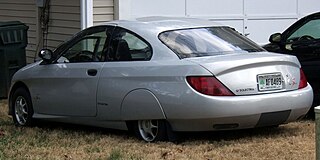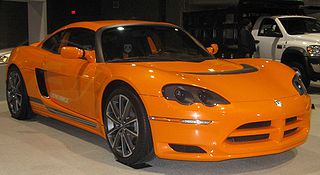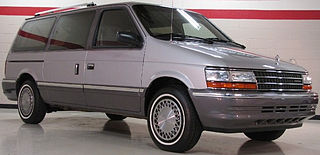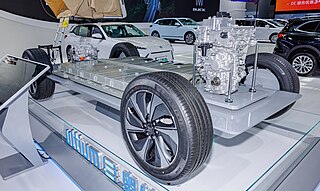
A hybrid vehicle is one that uses two or more distinct types of power, such as submarines that use diesel when surfaced and batteries when submerged. Other means to store energy include pressurized fluid in hydraulic hybrids.

The Grumman Long Life Vehicle (LLV) is an American light transport truck model designed as a mail truck for the United States Postal Service, which has been its primary user since it first entered service in 1986, 38 years ago. It was also used by Canada Post. The LLV uses a chassis built by GM based on the S-10 with an aluminum body built by Grumman.

The AMC Amitron was an experimental electric subcompact car built in 1967 by American Motors Corporation (AMC) and Gulton Industries. It included many advanced features, including regenerative braking and advanced battery designs, to provide a 150-mile (240 km) range on a single charge. Development ended because of technology issues and the high cost of batteries.

The Chrysler Town & Country is a minivan that was manufactured and marketed by Chrysler from 1990 to the 2016 model years. The third Chrysler minivan introduced in North America, the Town & Country adopted its nameplate from the flagship Chrysler station wagon line, adopting its exterior woodgrain trim as a design feature for several generations.

The Toyota RAV4 EV is an all-electric version of the popular RAV4 SUV produced by Toyota until 2014. Two generations of the EV model were sold in California, and to fleets elsewhere in the US, with a gap of almost ten years between them.

The Honda EV Plus was an experimental electric vehicle which was the first battery electric vehicle from a major automaker that did not use lead acid batteries. Roughly 340 EV Plus models were produced and released. Production of the EV Plus was discontinued in 1999 after Honda announced the release of its first hybrid electric vehicle, the Honda Insight.

The Chevrolet S-10 Electric was an American electric-powered vehicle built by Chevrolet. It was introduced in 1997, becoming the world's first electric pickup truck from the original manufacturer, updated in 1998, and then discontinued. It was an OEM BEV variant of Chevrolet's S-10 pickup truck. The S-10 Electric was solely powered by electricity (batteries) and was marketed primarily to utility fleet customers.

The Ford Ranger EV is a battery electric compact pickup truck that was produced by the Ford Motor Company and was the automaker's first all-electric production vehicle. It was produced starting in the 1998 model year through 2002 and is no longer in production. It is built upon a light truck chassis used in the Ford Explorer. Most vehicles were sold with nickel–metal hydride batteries (NiMH). A few vehicles with lead-acid batteries were sold, but most units were leased for fleet use.

The Dodge EPIC was a concept battery electric minivan designed and built by Dodge, using the drivetrain from the Chrysler TEVan. The EPIC was first shown at the 1992 North American International Auto Show. EPIC stands for Electric Power Interurban Commuter. After the show car was unveiled in 1992, a production version based on the third generation Chrysler minivans was made available to fleets between 1997 and 2003, sold as the Dodge Caravan EPIC and Plymouth Voyager EPIC.
The Dodge Intrepid ESX prototype cars are the result of the 1993 response by the Chrysler Corporation to a challenge by U.S. President Bill Clinton to produce a vehicle which was capable of meeting the demands of the modern consumer, while still achieving an unprecedented 80 miles per US gallon overall in fuel economy. The PNGV - Partnership for a New Generation of Vehicles project was aimed at The Big Three American car manufacturers.

The Solectria Sunrise was an innovative electric passenger car, designed to be as efficient as possible to produce long range from available battery technology.
ENVI was a division of American automobile manufacturer Chrysler formed in 2007 to create electric-drive vehicles and related advanced-propulsion technologies.
Solectria Corporation was responsible for the design, engineering, and manufacturing of energy management components for industrial applications, including electric vehicles, parallel hybrid drivetrains, and power generation applications. It was founded in 1989 and based in Woburn, Massachusetts. In December 2004, Solectria was acquired by Azure Dynamics.

An electric vehicle battery is a rechargeable battery used to power the electric motors of a battery electric vehicle (BEV) or hybrid electric vehicle (HEV).
Louis Rhodes is an American engineer. He was born at the Detroit Osteopathic Hospital in Michigan. He was employed as the director of design engineering at Chrysler LLC, an American automobile manufacturer. He has been in charge of various projects as the ME Four-Twelve, and the Chrysler Group's Minivan Stow ’n Go seating. On September 13, 2007, he was appointed president of ENVI, a division of Chrysler formed to develop electric-drive vehicles.

The Dodge EV concept car, also called Dodge Circuit EV sports car, was a two-passenger, rear-wheel-drive, all-electric sports car shown to the public at the 2009 North American International Auto Show by Dodge.

The Mazda Premacy Hydrogen RE Hybrid or Mazda5 Hydrogen RE Hybrid was a hydrogen powered hybrid car produced by Mazda. Later models were also called the Mazda Hydrogen RE Plug in Hybrid. The first car was unveiled in 2005, with an improved version shown at the 2007 Tokyo Motor Show. Mazda planned for the car to enter production and leased a few cars to end users in 2009 in 2010.

The Chrysler Pacifica is a minivan produced by the Chrysler division of Stellantis. It is unrelated to the discontinued crossover and concept vehicles by the same name and replaced the Chrysler Town & Country for the 2017 model year. It is positioned as the higher-end Chrysler minivan, above the Dodge Grand Caravan until 2020 and above the Chrysler Voyager since 2020.

The second-generation Chrysler minivans are a series of minivans that were manufactured and marketed by Chrysler Corporation in North America and Europe from 1991 to 1995. Officially designated the AS platform by Chrysler, the second-generation minivans were an extensive revision of the first-generation chassis and body. As before, passenger and cargo configurations were sold by Dodge, Plymouth, and Chrysler divisions. The first minivans offered with driver-side airbags and with optional integrated child safety seats, the second-generation Chrysler minivans offered all-wheel drive as an option for the first time; a manual transmission would be offered for the last time in the North American market.

Ultium is an electric vehicle battery and motor architecture developed by General Motors. It is being deployed for battery electric vehicles from General Motors portfolio brands along with vehicles from Honda and Acura.
















